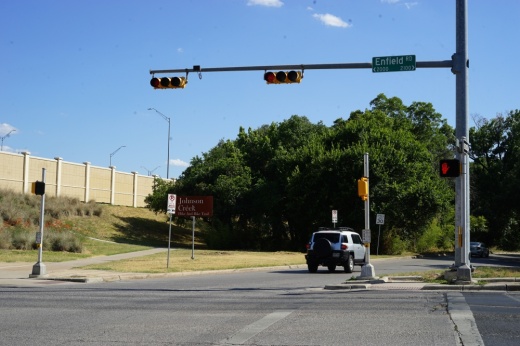On June 16, Austin City Council approved reducing the speed limit of almost 50 roads in the city as speeding is the No. 1 contributing factor of fatal car crashes in Austin, according to the Texas Department of Transportation.
More than 50 fatal accidents have happened in Austin this year as of late June, per city data. Speeding causes one out of every three traffic fatalities in Texas, according to state data.
"Nobody wants to die on the road," Lewis Leff, Vision Zero’s lead traffic safety officer said. "Nobody should die on the road. It's completely unacceptable that from this point forward, it's pretty likely that we'll have over 50 more people dying on the streets this year."
Further, traffic deaths have steadily increased in Austin since 2018, per data from Vision Zero—a city program centered on reducing traffic fatalities and serious injuries through education, policy and street improvement. Compared to last year, there has already been one more death, 22 more serious injuries, and 246 more accidents in 2022 as of July 4.
While the city of Austin, Travis County and TxDOT are working to advance policy and increase awareness on traffic safety, lack of enforcement remains an issue.
Austin Police Department Lt. William White said July 1 that staffing shortages have rendered traffic enforcement virtually nonexistent on certain Austin roads.
“We don’t have the staff to enforce the current speed limits, much less a change in the speed limits,” he said. “There’s no plan going forward as far as our traffic enforcement goes.”
Still some traffic experts said changing speed limits and focusing on education can make a difference.
Changing the limits
City action to reduce speed limits began in 2020 when the Austin Transportation Department ran a study that concluded many of Austin’s speed limits were “unreasonable and unsafe.”
On June 16, Austin City Council approved reducing the speed limit of almost 50 urban arterial street segments—a term defining busy main roads—in the city. The majority of streets were reduced by 5 mph; nine streets were reduced by 10 mph; and one street, McKinney Falls Parkway, will be reduced by 15 mph. The speed limits will be adjusted over the next few months, according to Jack Flagler, Austin public information specialist.
Leff said the city is reducing speed limits on the streets where the majority of injuries and deaths happen.
He added early data shows the speed limit reductions from 2020 are having a positive effect on traffic safety, though because the reductions happened so recently, Vision Zero staffers have yet to release hard data confirming their effectiveness.
Slower speeds reduce the number of accidents on roads, which causes less traffic to pile up and ultimately reduces costs stemming from public safety resources such as EMS and fire trucks, Leff said.
“[We just need] the majority of people to slow down a little bit,” Leff said.
At a June 28 meeting, the Travis County Commissioners Court voted not to change the speed limit of Braker Lane in the Whisper Valley neighborhood from 50 to 40 mph after concluding the change would be moot without the Austin Police Department enforcing it.
“What is the point of reducing the speed limit if we don’t have the staff to enforce it?” Precinct 2 Commissioner Brigid Shea said at the meeting.
For his part, White agrees the APD is understaffed and unable to provide the level of oversight needed to mitigate the situation in Austin.
ADP’s Driving While Intoxicated unit has been temporarily suspended and the motorcycle unit has been shifted to a volunteer-based program, according to APD’s website.
Staff at APD and Vision Zero recognize that without law enforcement, speed limit reductions and traffic safety education do not have as big an impact on accident reduction.
However, Leff said about 85% of motorists travel within 10 miles per hour of a given posted speed limit. Therefore, reducing speed limits can actually help lower average speeds in an area even if law enforcement is unavailable.
“There’s always going to be the five or 10% that go beyond [the speed limit], and there will need to be some level of regulation or enforcement [for those people],” Leff said.
Pedestrian safety
Pedestrians account for over a third of traffic deaths, according to city data, outnumbering bicycle, motorcycle and vehicle-on-vehicle deaths.
Data from the National Highway Transportation Safety Administration shows speeding not only increases motorists’ chances of being involved in an accident, but it also increases the severity of injuries caused by the crash, especially concerning car-on-pedestrian collisions.
For example, data from the National Association of City Transportation Officials states if a pedestrian is hit by a car going 23 mph, there is a 1 in 10 chance that person will die, but a driver who hits a pedestrian at 32 mph raises the odds to 1 in 4. At 50 mph, that rate jumps to 75%.
Traffic safety education
Employees at Driving on the Ride Side of the Road, a TxDOT program that offers free traffic safety resources to schools, courts and community organizations, agree that enforcement is a part of the solution to safer roads, but note that it does not have to mean punishment, but education.
“It doesn’t mean a monstrous fine,” said Elizabeth De La Garza, a TxDOT grant administrator with the Texas Municipal Courts Education Center who runs DRSR.
Rather, De La Garza said speedy drivers should have “meaningful consequences,” such as taking a driving safety course.
DRSR’s goal is to provide traffic safety education for drivers, young people who are pedestrians and passengers and older drivers adapting to a new world, according to Ryan Turner, Executive Director at Texas Municipal Courts Education Center.
“We’re not on the road alone; we’re a community,” Turner said.





